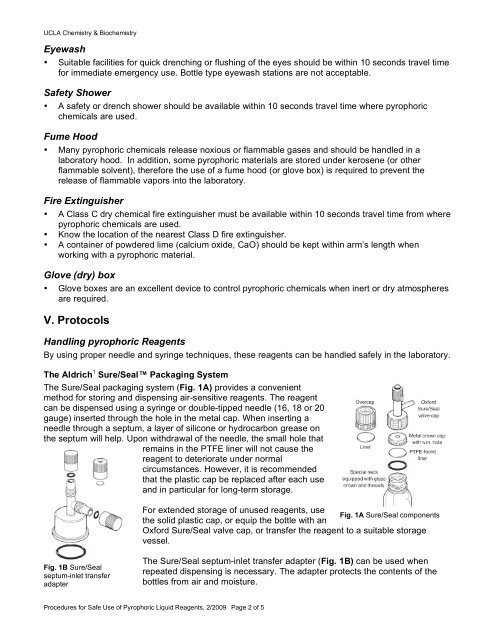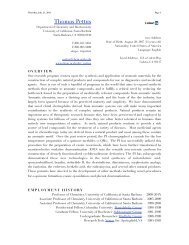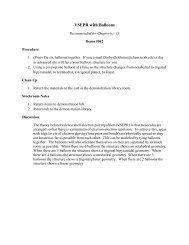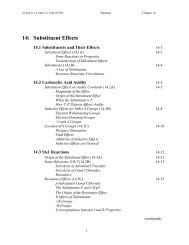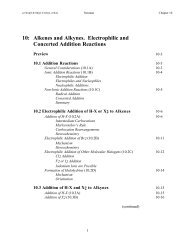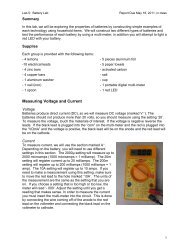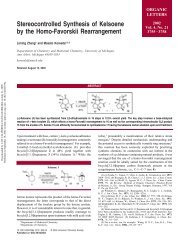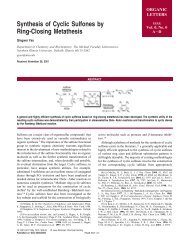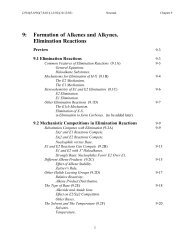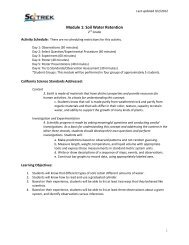Pyrophoric Liquid Reagents - UCLA Chemistry and Biochemistry
Pyrophoric Liquid Reagents - UCLA Chemistry and Biochemistry
Pyrophoric Liquid Reagents - UCLA Chemistry and Biochemistry
You also want an ePaper? Increase the reach of your titles
YUMPU automatically turns print PDFs into web optimized ePapers that Google loves.
<strong>UCLA</strong> <strong>Chemistry</strong> & <strong>Biochemistry</strong><br />
Eyewash<br />
• Suitable facilities for quick drenching or flushing of the eyes should be within 10 seconds travel time<br />
for immediate emergency use. Bottle type eyewash stations are not acceptable.<br />
Safety Shower<br />
• A safety or drench shower should be available within 10 seconds travel time where pyrophoric<br />
chemicals are used.<br />
Fume Hood<br />
• Many pyrophoric chemicals release noxious or flammable gases <strong>and</strong> should be h<strong>and</strong>led in a<br />
laboratory hood. In addition, some pyrophoric materials are stored under kerosene (or other<br />
flammable solvent), therefore the use of a fume hood (or glove box) is required to prevent the<br />
release of flammable vapors into the laboratory.<br />
Fire Extinguisher<br />
• A Class C dry chemical fire extinguisher must be available within 10 seconds travel time from where<br />
pyrophoric chemicals are used.<br />
• Know the location of the nearest Class D fire extinguisher.<br />
• A container of powdered lime (calcium oxide, CaO) should be kept within arm’s length when<br />
working with a pyrophoric material.<br />
Glove (dry) box<br />
• Glove boxes are an excellent device to control pyrophoric chemicals when inert or dry atmospheres<br />
are required.<br />
V. Protocols<br />
H<strong>and</strong>ling pyrophoric <strong>Reagents</strong><br />
By using proper needle <strong>and</strong> syringe techniques, these reagents can be h<strong>and</strong>led safely in the laboratory.<br />
The Aldrich 1 Sure/Seal Packaging System<br />
The Sure/Seal packaging system (Fig. 1A) provides a convenient<br />
method for storing <strong>and</strong> dispensing air-sensitive reagents. The reagent<br />
can be dispensed using a syringe or double-tipped needle (16, 18 or 20<br />
gauge) inserted through the hole in the metal cap. When inserting a<br />
needle through a septum, a layer of silicone or hydrocarbon grease on<br />
the septum will help. Upon withdrawal of the needle, the small hole that<br />
remains in the PTFE liner will not cause the<br />
reagent to deteriorate under normal<br />
circumstances. However, it is recommended<br />
that the plastic cap be replaced after each use<br />
<strong>and</strong> in particular for long-term storage.<br />
For extended storage of unused reagents, use<br />
Fig. 1A Sure/Seal components<br />
the solid plastic cap, or equip the bottle with an<br />
Oxford Sure/Seal valve cap, or transfer the reagent to a suitable storage<br />
vessel.<br />
Fig. 1B Sure/Seal<br />
septum-inlet transfer<br />
adapter<br />
The Sure/Seal septum-inlet transfer adapter (Fig. 1B) can be used when<br />
repeated dispensing is necessary. The adapter protects the contents of the<br />
bottles from air <strong>and</strong> moisture.<br />
Procedures for Safe Use of <strong>Pyrophoric</strong> <strong>Liquid</strong> <strong>Reagents</strong>, 2/2009 Page 2 of 5


